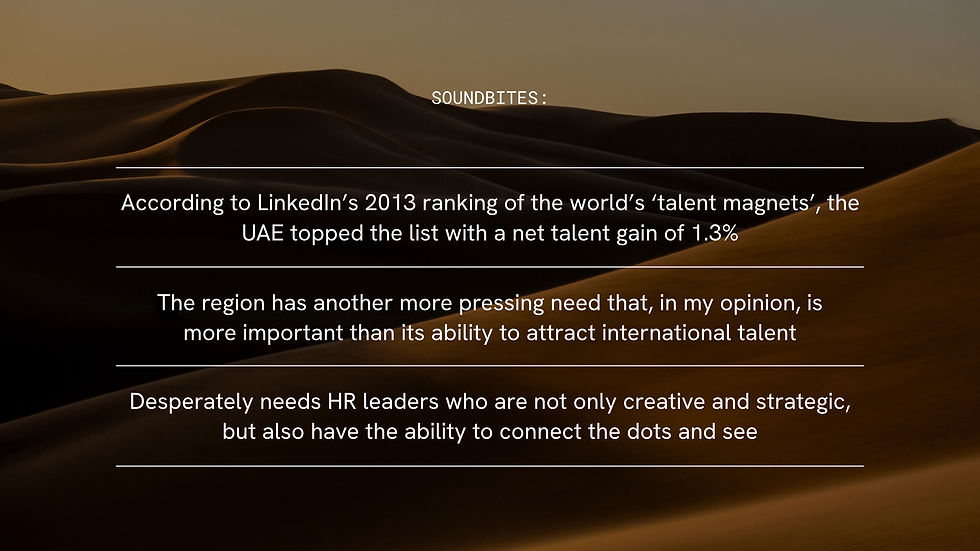
Talib Hashim offers us his thoughts about a possible new nationalisation roadmap for the region
Against a backdrop of the depressing events that have plagued the Middle East in recent years in particular, a small yet significant victory went unnoticed in the mainstream media and provided cause for celebration and pride to the people living in a small desert country in the Gulf known as the UAE.
This small victory came in the form of an announcement made by the world’s largest online professional network and recruitment platform, LinkedIn, that, according to its 2013 ranking of the world’s ‘talent magnets’, the UAE had topped its list with a net talent gain of 1.3%. The survey which measures the net international movement of talent among its members included countries like the UK, Spain, France, the US, Italy and Ireland. According to the survey, these countries are increasingly becoming ‘talent exporters.’
To comprehend the significance of this news you will have to understand that the ‘Arab brain drain’ issue has been a problem in the Arab world for decades. A study by Dr Ayman Al Zahri - an expert on migration studies at the Egyptian Society for Migration Studies - estimated that the number of Arabs who had migrated to the so called ‘developed’ countries had reached 35 million. This flight of human capital had begun by the end of the First World War. In 2010 the United Nations and the Arab League estimated the number of Arab experts and specialists was about one million with a very low rate of return to the region.
Personal Memories
For me, as well as other Arabs from my generation, the news was more personal. It brought back memories of the many passionate classroom lectures that were delivered on the topic of ‘Arab brain drain’ by school teachers who had lived through the regional conflicts. Often we were asked to write essays or discuss an article on the topic. In fact, I even remember a painting I drew during an art class portraying a group of Arab scientists getting off a plane that had landed in an Arab country. I wonder now that if the art teacher and the rest of the students in that class suspected that the piece of ‘art work’ was possibly a prophecy sketched by an unlikely twelve year old would they have laughed at me as hard as they did on that day?
There is no doubt that by reversing the ‘brain drain’ phenomenon the UAE - as well as some of the GCC countries such as Saudi Arabia which was also a gainer in the list - has crossed a significant historical milestone. Notwithstanding this accomplishment and without wishing to be seen as the one to ‘rain on the parade,’ the region has another more pressing need that, in my opinion, is more important than its ability to attract international talent. This urgent need is the employment, development and empowerment of these countries’ local talent, otherwise loosely known as ‘nationalisation.’
A lost generation?
Nationalisation will not only continue to grow as a regional imperative in the Gulf but also across the wider Arab world; as more young, ambitious and educated youth enter the market and seek their place in a fast-changing world. The Middle East currently has among the highest unemployment rates of any region in the world for people between the ages of 15 and 24; one out of four young people in the labor market are unemployed. A growing number of these countries are now exploring and implementing programs and initiatives designed to empower their own local population.
For the talent either returning to this region or arriving for the first time, the landscape has changed significantly in the last twenty years or so. The Gulf countries are experiencing a youth bulge with up to one-third of its population are under the age of 25. Illiteracy, which was a key problem that had plagued the region, has now been significantly diminished with countries such as the UAE reducing its illiteracy rate from 75.1 % in 1971 to below 1% while Saudi Arabia has now achieved 96% literacy rate. More nationals are pursuing higher education with 100,000 university students graduating from Saudi Arabia every year, while the UAE is seeing a year on year increase in number of graduates with at least 100,000 graduates are expected to enter the workforce in the next 10 years.
While these statistics alone look impressive, the ailment the GCC countries are facing has been in the form of a nagging unemployment problem that refuses to go away in spite of an encouraging increase in job creation in particular in Saudi Arabia, the UAE and Qatar. The inevitable question that comes to mind in view of this is; now that we have managed to reverse the ‘brain drain’ phenomenon to ‘brain gain’ and continue to attract global talent to our cities, how do we also ensure that the local talent is competitive and empowered enough so that they play a role in the social and economic development in the region?
A sustainable and cohesive strategy
I have always believed and preached that more than government legislation, quotas and penalties; employers and in particular the ever growing private sector in the Gulf, play a vital role in addressing this question. This starts with companies accepting that it is imperative that they not only understand the national and societal priorities in the region but are also aligned to these priorities. What needs to happen next is a shift from a somewhat transactional approach where the sole purpose is employing numbers or achieving quotas to a more sustainable and cohesive strategy. A strategy that ensures that employers are gaining business value from employing nationals, and nationals employed in these organisations are also benefitting from their employment in this critical sector.
The key ingredients for this are what I refer to as the ‘Nationalisation Roadmap.’ This roadmap encourages employers to ask themselves critical questions such as; “how are we engaging national youth talent today?”, “how creative and robust is our recruitment process?”, “how can we foster smooth integration of local and international culture in our workplace?” and “how are we instilling leadership skills across all levels?”
To achieve this, the region desperately needs HR leaders who are not only creative and strategic, but also have the ability to connect the dots and see what is in stake here. Perhaps the ruler of Dubai and Prime Minister of the UAE, His Highness Sheikh Mohammed Bin Rashid put it best in his article addressing the ranking announced by LinkedIn when he stated that: “Part of the tragedy playing out in Middle Eastern countries beset by conflict and instability is that if only their most talented sons and daughters could apply their skills at home, they would become part of the solution: agents of peace through development.”

An article written by Talib Hashim

Talib Al Hashimi is a distinguished expert in localization, talent development, and strategic business advisory, with a focus on the UAE and GCC markets. With over 15 years of experience, Talib has successfully placed Emiratis in senior roles and led numerous talent acquisition campaigns for major projects, including the Dubai Metro and Sharjah Airport. His work encompasses enhancing human resource practices, business development, and strategic planning. Talib has also played a part of the Dubai Strategic Plan 2021.

Comments